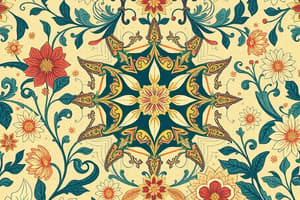Podcast
Questions and Answers
List four properties of vectors.
List four properties of vectors.
- Self-replication capability, 2. Ability to recognize sequence for a restriction enzyme, 3. Should be small in comparison to host chromosome, 4. Can be plasmids, artificial chromosomes, or viruses.
What is biotechnology?
What is biotechnology?
The use of microorganisms, cells, or cell components to make a product.
What is Recombinant DNA Technology (rDNA)?
What is Recombinant DNA Technology (rDNA)?
DNA that has been artificially manipulated to combine genes from two different sources.
Define genetic engineering.
Define genetic engineering.
What is a vector?
What is a vector?
What is a clone?
What is a clone?
What is the role of a clone and a vector in genetic engineering?
What is the role of a clone and a vector in genetic engineering?
How is selection used in biotechnology?
How is selection used in biotechnology?
How is mutation used in biotechnology?
How is mutation used in biotechnology?
What are restriction enzymes?
What are restriction enzymes?
Describe the use of plasmids.
Describe the use of plasmids.
Describe the use of viral vectors.
Describe the use of viral vectors.
Outline the PCR process.
Outline the PCR process.
What is electroporation?
What is electroporation?
What is transfection?
What is transfection?
What is transformation in the context of getting DNA into a cell?
What is transformation in the context of getting DNA into a cell?
What is protoplast fusion?
What is protoplast fusion?
What is microinjection?
What is microinjection?
What are gene libraries?
What are gene libraries?
What is cDNA?
What is cDNA?
Flashcards are hidden until you start studying
Study Notes
Properties of Vectors
- Vectors replicate desired DNA sequences autonomously once inside a host cell.
- Must contain unique genetic markers for recognition by restriction enzymes.
- Should be smaller than the host chromosome for efficient gene transfer.
- Common types of vectors include plasmids, artificial chromosomes, and viruses.
Biotechnology
- Involves using microorganisms and cells to produce products not normally synthesized by them.
- Microorganisms and plants serve as factories for chemical production.
Recombinant DNA Technology (rDNA)
- Entails the artificial manipulation of DNA from different sources.
- Enables amplification of DNA, allowing for mass replication of specific DNA sequences.
Genetic Engineering
- Involves inserting genes into cells, facilitating gene transfer between unrelated species in a laboratory setting.
Vector
- A self-replicating DNA entity that carries a desired gene into a new cell.
Clone
- A population of genetically identical cells derived from a single parent cell.
Role of Clones and Vectors in Genetic Engineering
- Desired genes are inserted into vectors like plasmids or viral genomes.
- The vector delivers DNA into a new cell, which multiplies to form clones for gene or product harvesting.
Selection in Biotechnology
- Involves artificial selection of microbes exhibiting desirable traits for culturing purposes.
Mutation in Biotechnology
- Mutagens induce mutations to develop microbes with favorable characteristics.
- Site-directed mutagenesis alters specific codons in genes for desired outcomes.
Restriction Enzymes
- A class of DNA-cutting enzymes found in bacteria, characterized by their specificity.
- "Sticky" ends produced by some enzymes promote the joining of DNA fragments.
- DNA ligase seals the backbones of resulting DNA fragments.
Use of Plasmids
- Plasmids function as vehicles to carry desired DNA sequences in genetic engineering.
Use of Viral Vectors
- Essential in gene therapy applications where viruses introduce new genes into target cells.
- Vectors replicate inserted DNA during the gene transfer process.
PCR Outline
- Denaturation: High temperature (94°C) breaks hydrogen bonds in DNA.
- Priming: Lower temperature allows primers to bind to single-stranded DNA.
- Extension: Intermediate temperature facilitates DNA polymerase replication.
- Each PCR cycle doubles the DNA, enabling significant amplification over multiple rounds.
Electroporation
- A technique using electrical currents to create temporary pores in cell membranes for DNA entry.
Transfection
- Multiple methods are employed for introducing DNA, varying by cell type.
Transformation
- A process where genes are taken up by bacteria as "naked" DNA from the surrounding solution.
Protoplast Fusion
- Joins two cells by removing their cell walls, utilized in various genetic engineering techniques.
Microinjection
- A method for injecting DNA directly into cells, particularly useful in protoplasts and embryos.
Gene Libraries
- Constructed by fragmenting an entire genome with restriction enzymes and inserting DNA fragments into plasmids or phages.
cDNA (Complementary DNA)
- Generated from mRNA using reverse transcriptase, cDNA can be cloned in gene libraries with eukaryotic origins.
Studying That Suits You
Use AI to generate personalized quizzes and flashcards to suit your learning preferences.




